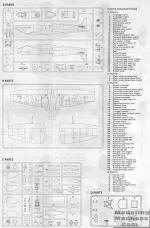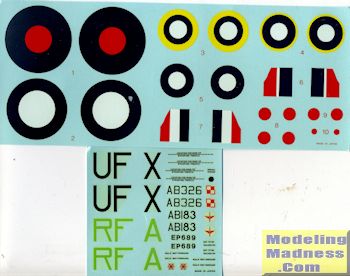
Hasegawa 1/32 Spitfire Vb
| KIT #: | S018 |
| PRICE: | Varies: this kit was $15.00 on the 'used kit' market |
| DECALS: | Three options |
| REVIEWER: | Scott Van Aken |
| NOTES: |

| HISTORY |
Late in 1940, the RAF predicted that the advent of the pressurised Junkers Ju 86P bomber series over Britain would be the start of a new sustained high altitude bombing offensive by the Luftwaffe, in which case development was put in hand for a pressurised version of the Spitfire, with a new version of the Merlin (the Mk VI). It would take some time to develop the new fighter and an emergency stop-gap measure was needed as soon as possible: this was the Mk V.
The basic Mk V was a Mk I with the Merlin 45 series engine. This engine delivered 1,440 hp (1,074 kW) at take-off, and incorporated a new single-speed single-stage supercharger design. Improvements to the carburettor also allowed the Spitfire to use zero gravity manoeuvres without any problems with fuel flow. Several Mk I and Mk II airframes were converted to Mk V standard by Supermarine and started equipping fighter units from early 1941. The majority of the Mk Vs were built at Castle Bromwich.
The VB became the main production version of the Mark Vs. Along with the new Merlin 45 series the B wing was fitted as standard. As production progressed changes were incorporated, some of which became standard on all later Spitfires. Production started with several Mk IBs which were converted to Mk VBs by Supermarine. Starting in early 1941 the round section exhaust stacks were changed to a "fishtail" type, marginally increasing exhaust thrust. Some late production VBs and VCs were fitted with six shorter exhaust stacks per side, similar to those of Spitfire IXs and Seafire IIIs; this was originally stipulated as applying specifically to VB(trop)s. After some initial problems with the original Mk I size oil coolers, a bigger oil cooler was fitted under the port wing; this could be recognised by a deeper housing with a circular entry. From mid-1941 alloy covered ailerons became a universal fitting.
A constant flow of modifications were made as production progressed. A "blown" cockpit hood, manufactured by Malcolm, was introduced in an effort to further increase the pilot's head-room and visibility. Many mid to late production VBs - and all VCs - used the modified, improved windscreen assembly with the integral bullet resistant centre panel and flat side screens introduced with the Mk III. Because the rear frame of this windscreen was taller than that of the earlier model the cockpit hoods were not interchangeable and could be distinguished by the wider rear framing on the hood used with the late-style windscreen.
Different propeller types were fitted, according to where the Spitfire V was built: Supermarine and Westland manufactured VBs and VCs used 10 ft 9 in (3.28 m) diameter, 3 bladed de Havilland constant speed units, with narrow metal blades, while Castle Bromwich manufactured VBs and VCs were fitted with a wide bladed Rotol constant speed propeller of either 10 ft 9 in (3.28 m) diameter, with metal blades, or (on late production Spitfires) 10 ft 3 in (3.12 m) diameter, with broader, "Jablo" (compressed wood) blades. The Rotol spinners were longer and more pointed than the de Havilland leading to a 3.5 in (8.9 cm) increase in overall length. The Rotol propellers allowed a modest speed increase over 20,000 ft (6,100 m) and an increase in the service ceiling. A large number of Spitfire VBs were fitted with "gun heater intensifier" systems on the exhaust stacks. These piped additional heated air into the gun bays. There was a short tubular intake on the front of the first stack and a narrow pipe led into the engine cowling from the rear exhaust.
The VB series were the first Spitfires able to carry a range of specially designed "slipper" drop tanks which were fitted underneath the wing centre-section. Small hooks were fitted, just forward of the inboard flaps: when the tank was released these hooks caught the trailing edge of the tank, swinging it clear of the fuselage.
With the advent of the superb Focke Wulf Fw 190 in August 1941 the Spitfire was for the first time truly outclassed, hastening the development of the "interim" Mk IX. In an effort to counter this threat, especially at lower altitudes, the VB was the first production version of the Spitfire to use "clipped" wingtips as an option, reducing the wingspan to 32 ft 2 in (9.8 m).The clipped wings increased the roll rate and airspeed at lower altitudes. Several different versions of the Merlin 45/50 family were used, including the Merlin 45M which had a smaller "cropped" supercharger impeller and boost increased to +18 lb. This engine produced 1,585 hp (1,182 kW) at 2,750 ft (838 m), increasing the L.F VB's maximum rate of climb to 4720 ft/min (21.6 m/s) at 2,000 ft (610 m).
The Mk VB(trop) (or type 352) could be identified by the large Vokes air filter fitted under the nose; the reduced speed of the air to the supercharger had a detrimental effect on the performance of the aircraft, reducing the top speed by 8 mph (13 km/h) and the climb rate by 600 ft/min (3.04 m/s), but the decreased performance was considered acceptable. This variant was also fitted with a larger oil tank and desert survival gear behind the pilot's seat. A new "desert" camouflage scheme was applied. Many VB(trop)s were modified by 103 MU (Maintenance Unit-RAF depots in which factory fresh aircraft were brought up to service standards before being delivered to squadrons) at Aboukir, Egypt by replacing the Vokes filter with locally manufactured "Aboukir" filters, which were lighter and more streamlined. Two designs of these filters can be identified in photos: one had a bulky, squared off filter housing while the other was more streamlined. These aircraft were usually fitted with the wide blade Rotol propeller and clipped wings.
| THE KIT |
 This
kit has been around for quite a number of years, first appearing in the 1970s.
As such, the aircraft external detailing is mostly raised, though some,
such as some hatches and control surfaces, for example are engraved. I'll let
the boffins comment on what is wrong with the kit as I'm sure there is
something, but it looks nice to me. Cockpit detailing isn't all that bad. There
is a floor with separate rudder pedals and control stuck with the rudder
actuating pistons that go under the floor. The seat has armor and a three piece
mount that fits to the rear bulkhead. There is a separate instrument panel with
gun sight and a decal for the compass and instrument panel. On the back of the
bulkhead behind the seat is either a round or square electrical junction box (at
least that is what I think it is). The seat has no belts as one is expected to
fill it with the pilot figure.
This
kit has been around for quite a number of years, first appearing in the 1970s.
As such, the aircraft external detailing is mostly raised, though some,
such as some hatches and control surfaces, for example are engraved. I'll let
the boffins comment on what is wrong with the kit as I'm sure there is
something, but it looks nice to me. Cockpit detailing isn't all that bad. There
is a floor with separate rudder pedals and control stuck with the rudder
actuating pistons that go under the floor. The seat has armor and a three piece
mount that fits to the rear bulkhead. There is a separate instrument panel with
gun sight and a decal for the compass and instrument panel. On the back of the
bulkhead behind the seat is either a round or square electrical junction box (at
least that is what I think it is). The seat has no belts as one is expected to
fill it with the pilot figure.
There are separate interior side panels with various instruments to attach thereupon. Once all these bits are attached and painted, an additional aft bulkhead is added and the fuselage halves glued together.
The wings are a single piece lower and two upper halves. There is a separate coolant radiator piece and one attaches a pair of landing lights into the lower wing before cementing the wing upper halves. The cannon barrels are molded with the upper wings. There are no outer machine gun holes, only raised plates that are apparently, supposed to be the doped fabric patches put over the openings to prevent sand and dirt from getting into the gun barrels. Tail planes are upper and lower halves with the elevator molded in the upper section. Similarly, the rudder is molded into the left fuselage half. Wings can use either a clipped or standard wing tip depending on your markings option.
For the lower nose there is a separate cowling piece and a
choice of carb intake sections. One is the standard version, then you can use
the more streamlined Aboukir filter or the large bulky Vokes filter. A
centerline fuel tank is provided for the Vokes option. A three piece cockpit
clear bits suite is provided. There are two canopy sections so I'm guessing one
is for the open cockpit option. You can also have the cockpit door open. It
comes with a  crowbar
which may or may not have been installed. Two different props are provided. One
is a deHavilland version and the other the broader Rotol.
crowbar
which may or may not have been installed. Two different props are provided. One
is a deHavilland version and the other the broader Rotol.
Instructions are nicely done with what appears to be Humbrol paint codes as well as generic color information. Markings are for three planes. Two are desert scheme aircraft. One is the box art plane from 601 squadron in 1943 with the Aboukir filter. This plane has the clipped wing tips. The other has the Vokes filter and is from 145 squadron in mid 1942. This has the early war insignia and no codes. This one shows the deHavilland prop. The third is a standard European camouflage scheme as flown with 303 squadron in early 1942.
| CONCLUSIONS |
Despite its age, it looks like it will make into a very nice model. Though it will probably be surpassed if Revell AG ever markets their Spit IIa as a mk V, right now it is probably still one of the best in this scale.
| REFERENCES |
https://en.wikipedia.org/wiki/Supermarine_Spitfire_%28early_Merlin-powered_variants%29
October 2015 Thanks to me
for the preview kit. If you would like your product reviewed fairly and fairly quickly, please
contact
the editor or see other details in the
Note to
Contributors.